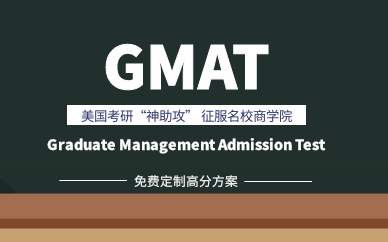
發(fā)布時間:2021-05-14 09:07:38來源:轉(zhuǎn)載
GMAT語法SC部分考點眾多,各類涉及到英語語法的內(nèi)容都有可能出現(xiàn)在題目中,對于考生的英語書面語法能力有較高要求。而在所有考點中,一致性問題又是出現(xiàn)頻率最高的考點之一。本文將盤點GMAT語法中常見的8大一致性問題相關(guān)考點和題目。

GMAT語法一致性問題詳解
所謂語法上一致就是謂語動詞和主語在單、復數(shù)形式上保持一致。這個考點光從字面上來看貌似十分簡單,但涉及到具體題目中卻往往會成為扣分殺手。具體來說,在GMAT語法中有關(guān)一致性的具體考點主要有以下8種:
1. 主謂語單復數(shù)一致性
以單數(shù)名詞或代詞、動詞不定式短語、動名詞短語或從句作主語時,謂語動詞一般用單數(shù)形式;主語為復數(shù)時,謂語動詞用復數(shù)形式。
如:His father is working on the farm. / To study English well is not easy. / What he said is very important for us all. / The children were in the classroom two hours ago. / Reading in the sun is bad for your eyes.
注意:由what引導的主語從句,后面的謂語動詞多數(shù)情況用單數(shù)形式,但若表語是復數(shù)或what從句是一個帶有復數(shù)意義的并列結(jié)構(gòu)時,主句的謂語動詞用復數(shù)形式。如:What I bought were three English books. / What I say and do is (are) helpful to you.
2. 合成主語必須用復數(shù)形式
由連接詞and或both …… and連接起來的合成主語后面,要用復數(shù)形式的謂語動詞。
3. 名詞或代詞短語不影響單復數(shù)形式
主語為單數(shù)名詞或代詞,盡管后面跟有with, together with, except, but, like, as well as, rather than, more than, no less than, besides, including等引起的短語,謂語動詞仍用單數(shù)形式;若主語為復數(shù),謂語用復數(shù)形式。
如:Mr. Green, together with his wife and children, has come to China. / Nobody but Jim and Mike was on the playground. / She, like you and Tom, is very tall.
4. 復合不定代詞如何判斷單復數(shù)?
either, neither, each, every 或no +單數(shù)名詞和由some, any, no, every構(gòu)成的復合不定代詞,都作單數(shù)看待。
如:Each of us has a new book. / Everything around us is matter.
注意:(1)在口語中當either或neither后跟有“of+復數(shù)名詞(或代詞)”作主語時,其謂語動詞也可用復數(shù)。如:Neither of the texts is (are) interesting. (2)若none of后面的名詞是不可數(shù)名詞,它的謂語動詞就要用單數(shù);若它后面的名詞是復數(shù),它的謂語動詞用單數(shù)或復數(shù)都可以。如:None of us has (have) been to America.
5. 關(guān)系代詞做主語時的單復數(shù)問題
在定語從句時,關(guān)系代詞that, who, which等作主語時,其謂語動詞的數(shù)應與句中先行詞的數(shù)一致。
如:He is one of my friends who are working hard. / He is the only one of my friends who is working hard.
如:Lucy and Lily are twins. / She and I are classmates. / The boy and the girl were surprised when they heard the news. / Both she and he are Young Pioneers.
注意:(1)若and所連接的兩個詞是指同一個人或物時,它后面的謂語動詞就應用單數(shù)形式。如:The writer and artist has come. (2)由and連接的并列單數(shù)主語前如果分別有no, each, every more than a (an) , many a (an)修飾時,其謂語動詞要用單數(shù)形式。如:Every student and every teacher was in the room. / No boy and no girl likes it.
6. 集體名詞單復數(shù)使用差異
如果集體名詞指的是整個集體,它的謂語動詞用單數(shù);如果它指集體的成員,其謂語動詞就用復數(shù)形式。這些詞有family, class, crowd, committee, population, audience等。
如:Class Four is on the third floor. / Class Four are unable to agree upon a monitor.
注意:people, police, cattle等名詞一般都用作復數(shù)。如:The police are looking for the lost child.
7. 數(shù)量詞構(gòu)成短語的單復數(shù)用法
由“a lot of, lots of, plenty of, the rest of, themajorityof + 名詞”構(gòu)成的短語以及由“分數(shù)或百分數(shù)+名詞”構(gòu)成的短語作主語,其謂語動詞的數(shù)要根據(jù)短語中后面名詞的數(shù)而定。
如:There are a lot of people in the classroom. / The rest of the lecture is wonderful. / 50% of the students in our class are girls.
注意:a number of“許多”,作定語修飾復數(shù)名詞,謂語用復數(shù);the number of“……的數(shù)量”,主語是number,謂語用單數(shù)。
8. 倒裝句中的動詞單復數(shù)問題
在倒裝句中,謂語動詞的數(shù)應與其后的主語一致。如:There comes the bus. / On the wall are many pictures. / Such is the result. / Such are thefacts.
總而言之,一致性問題作為GMAT語法SC的主要考點,還是值得考生投入一些時間精力認真?zhèn)淇嫉模M衔奶岬降倪@些一致性相關(guān)考點,大家能夠有所了解,提前做好準備,以確保語法部分的順利得分。